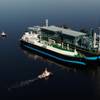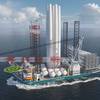The U.S. Gulf Market: When Will It Turn Around?
It seems everyday during the last several months, the top question on everyone's mind is 'When will things turn around?' Discussions around our office and with various clients usually entail an exchange of anecdotal information believed to explain the current situation with the quest to predict when things will turn around. There are a host of different viewpoints, most seemingly relevant, but no one satisfactory answer.
In previous downturns in the offshore service sector, there was usually a fairly clear understanding embraced by most of why things were slow. This downturn is more difficult to understand. Back in 1998 when the Asian financial crisis impacted oil prices, it was easy to see why E&P fell. This downturn also affected most oil fields around the world about the same. The price of oil was too low to drill new wells and upgrade production at a profit. But at that time, it was also clear that the overall economy was strong, prices would recover, and eventually the service sector would pick back up. This came to pass in 2000 when slowly but surely utilization and day rates went back up for drill rigs and support vessels about 6 months after oil recovered. Part of the recovery in the U.S. Gulf was due to spiraling natural gas prices. Prices started their rapid accent around June 2000. The offshore vessel market was in a recovery by fall of 2000.
During the current downturn in the U.S. Gulf, oil prices are in the mid-twenties, which is higher than they were during the boom years in the mid-1990's. Yet the U.S. Gulf market is suffering low utilization and lowered day rates. The current downturn seemed to start last fall and gain momentum over the winter months. Coincidently, natural gas prices took a nosedive, after peaking at 3 times historic levels in about December 2000 and falling to below historic support levels by June 2001. The price of natural gas peaked at around $9 per thousand cubic feet, then crashed to slightly above $2 and has since stabilized around $3. The current price is near the levels seen in 1999 before the rapid price accent started. The majority of offshore rig activity in the U.S. Gulf is based on natural gas.
The price boom in natural gas lasted about one year. The market had been growing with stable prices for years before the boom.
Much of the run-up in natural gas prices can be attributed to energy traders and the long-term movement of utilities from coal or oil to cleaner burning natural gas. This movement began in the early 1990's following the U.S. Government's Clean Air Act. The rapid price rise in 2000/2001 contributed to the 'energy crisis' experienced in the Western U.S. All consumers of natural gas, including power plants, were suffering from what was perceived as a shortage. This drove up prices and created a boom in offshore and land based drilling for natural gas. In 2000/2001, the drilling industry witnessed the highest number of active natural gas exploratory drilling rigs in U.S. history. By spring of 2002, the number of active land and offshore rigs combined had fallen in half. Although high natural gas prices helped carry the offshore vessel market out of the doldrums in 2000, we are now paying the price for an overheated market. The good news is that the consumption of natural gas continues to rise and is forecasted to steadily rise over the coming decades.
According to the Short-Term Energy Outlook - August 2002 from the Energy Information Administration of the Department of Energy, natural gas wellhead prices for the upcoming winter will average about $3.12 per thousand cubic feet. This is about 10 to 15 percent higher than current prices and about 70 cents higher than winter last year. The same agency is forecasting 2003 natural gas wellhead prices to average just over $3 per thousand cubic feet for the entire year. Both forecasts assume normal weather.
In other parts of the world, where crude oil is the main commodity, utilization and day rates are relatively stable. In the U.S. Gulf, where gas drilling plays a much greater roll, utilization is near all time lows.
Besides the upset in natural gas prices, there are other reasons the offshore market is slow. Oil majors are all coming off a quarter of declining profits. Most of the oil majors are down about 40% off last year's record profits with some taking a harder hit from bad investments. The refining market is reportedly the toughest in years with strong crude prices and lowered demand for refined products.
The crude oil market remains somewhat shaky, although prices are high. The world's demand for crude oil has not declined, but the rate of growth in demand has diminished from the levels seen in the 1990's. In July, the International Energy Agency cut their forecast for the growth of crude oil demand to 250,000 barrels per day (bpd) year over year down from their previous forecasted growth of 420,000 bpd. They predict the demand growth will return to 400,000 bpd during the second half of 2002 and demand growth will recover next year to 1.1 million bpd, returning to levels seen during the 1990's. This year the Agency is forecasting overall world consumption to rise to an average of 76.15 million barrels per day. This indicates only about ¼ the growth in daily consumption seen in the 1990's. Next year's world consumption is forecast to rise to 77.25 bpd.
OPEC continues to be active in their control of oil output. OPEC controls about 40% of current world oil production. Their production cuts have kept prices higher during the latest recession, avoiding sharp price declines experienced during past demand slumps. The last demand slump caused by the Asian financial crisis in 1998 resulted in prices crashing to near $10 per barrel. OPEC's efforts over the last 2 to 3 years since that crisis have buoyed oil prices, but some say the high prices have caused some of the drop in demand and slow economic recovery. OPEC also faces losing market share to competing suppliers of crude oil, such as Russia and other producers who are not operating at full capacity. The high prices usually entice western oil majors to increase E&P, which also cuts into OPEC's market share during periods of slow demand growth.
During the Asian financial crisis, other economies around the world remained strong. Lower oil prices may have aided in keeping other economies from stumbling. The September 11th, 2001 terrorist attacks and pre-September 11th slowdown in business travel have severely impacted the consumption of jet fuel worldwide. The current slow down in oil demand growth can be attributed to several factors including the terrorist attacks, but also to the economic slowdown caused by instability in financial markets, which has slowed business spending. The business spending recession can be traced back to the major stock market decline in the U.S., which commenced during March of 2000 following the extensive run-up to Y2K. It's debatable whether the stock market decline causes spending cuts or the cuts caused the market's decline, but it was probably a mixture of both. The current decline in the financial markets may or may not have reached a bottom. The pace of business spending was bound to decline from the heights reached in the late 1990's, which was based largely on preparing for Y2K and companies taking advantage of internet technologies to increase productivity. Business spending was also fueled by the speculative stock market creating a ready source of investment funds. Companies now face greater scrutiny from investors and banks.
All this may seem unrelated to oil and gas exploration and production, but there is a connection. Energy demand is ultimately tied to the size of the world economy and the growth of that economy. The health of the world economy has a direct impact on oil and gas consumption. Although market prices for oil and gas fluctuate in the short term based on cartel or other price controls, weather, politics, and market innuendo, long-term demand is tied to economic health. The long-term average prices are tied to supply, demand, and increases in upstream / downstream productivity.
Given that the offshore market is reliant on E&P budgets and the size of those budgets stem from confidence in the economy and politics, it is reasonable to look to the economy and politics to see when the offshore service sector is due for a recovery. But, the key factor in an offshore market recovery will be the short to mid term demand for oil and natural gas. As witnessed in 2000 / 2001 in the U.S. Gulf, the offshore vessel market can prosper in an economic recession if oil and gas prices are stable. The long-term market for oil and gas is made up of short-term market ups and downs. Drilling can be driven by short-term prices alone for both oil and gas.
So, when will the U.S. Gulf offshore vessel market turn around? Is a U.S. economic recovery necessary? Based on past history, not necessarily. Even with the rate of oil demand growth shrinking worldwide, but prices staying high, offshore markets primarily driven by crude oil E&P have enjoyed reasonable utilization and day rates. Natural gas driven offshore markets have experienced a downturn, but not in sequence with the rest of the economy. The current downturn came as a result of a crash in natural gas prices due to over production and market turmoil caused by energy traders and speculators. Although the natural gas market remains low, the price is not bad compared to prices over the last decade. The over production of the 2000 / 2001 boom will slowly work through the system since demand remains relatively stable. Once this over capacity stabilizes, drilling on land and offshore will slowly pick up. A strong economy could drive the market faster, but a weak economy also consumes enough natural gas to gradually lift the market.
There is already evidence that the rig count has bottomed and is in an upward turn. Natural gas prices seemed to have bottomed in winter 2001 and have been slowly rebounding since then. If we have a normal or cold winter in North America this year, we could see much higher utilization of offshore vessels within the next six months.
Environmental concerns will also help the offshore market. With environmental restrictions on land based drilling in various areas of the U.S., there will be more offshore drilling for natural gas in U.S. Gulf waters.
Predicting any market is difficult with political, economic, and weather factors involved. But, excepting any major changes in the current trends, the offshore vessel market can recover before the general economy. The main factors necessary for a recovery of the U.S. Gulf offshore vessel market include; continued stable oil prices, a return to normal rates of natural gas drilling, and a relatively stable economic and political climate. The preceding report was written by John Braden ([email protected]) and was originally featured on the company's website at www.marcon.com.










